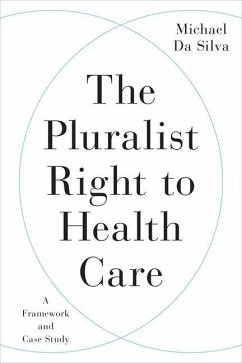- Gebundenes Buch
- Merkliste
- Auf die Merkliste
- Bewerten Bewerten
- Teilen
- Produkt teilen
- Produkterinnerung
- Produkterinnerung
Offering a new conception of the right to health care as a complex but morally justifiable and realistically achievable right, this book helps resolve persistent problems with the idea of health rights.
Andere Kunden interessierten sich auch für
![From Enforcers to Guardians From Enforcers to Guardians]() Hannah L. F. Cooper (Associate Professor and Emory Univ Vice ChairFrom Enforcers to Guardians29,99 €
Hannah L. F. Cooper (Associate Professor and Emory Univ Vice ChairFrom Enforcers to Guardians29,99 €![Credible Credible]() Deborah TuerkheimerCredible29,99 €
Deborah TuerkheimerCredible29,99 €![Scoundrel Scoundrel]() Sarah WeinmanScoundrel16,99 €
Sarah WeinmanScoundrel16,99 €![Scoundrel Scoundrel]() Sarah WeinmanScoundrel31,99 €
Sarah WeinmanScoundrel31,99 €![What Matters Most What Matters Most]() Chanel ReynoldsWhat Matters Most20,99 €
Chanel ReynoldsWhat Matters Most20,99 €![Duties to Care Duties to Care]() Rosie Harding (University of Birmingham)Duties to Care137,99 €
Rosie Harding (University of Birmingham)Duties to Care137,99 €![Digital Health Care outside of Traditional Clinical Settings Digital Health Care outside of Traditional Clinical Settings]() Digital Health Care outside of Traditional Clinical Settings38,99 €
Digital Health Care outside of Traditional Clinical Settings38,99 €-
-
-
Offering a new conception of the right to health care as a complex but morally justifiable and realistically achievable right, this book helps resolve persistent problems with the idea of health rights.
Hinweis: Dieser Artikel kann nur an eine deutsche Lieferadresse ausgeliefert werden.
Hinweis: Dieser Artikel kann nur an eine deutsche Lieferadresse ausgeliefert werden.
Produktdetails
- Produktdetails
- Verlag: University of Toronto Press
- Seitenzahl: 328
- Erscheinungstermin: 2. Dezember 2021
- Englisch
- Abmessung: 229mm x 152mm x 22mm
- Gewicht: 658g
- ISBN-13: 9781487508722
- ISBN-10: 1487508727
- Artikelnr.: 60599671
- Herstellerkennzeichnung
- Libri GmbH
- Europaallee 1
- 36244 Bad Hersfeld
- gpsr@libri.de
- Verlag: University of Toronto Press
- Seitenzahl: 328
- Erscheinungstermin: 2. Dezember 2021
- Englisch
- Abmessung: 229mm x 152mm x 22mm
- Gewicht: 658g
- ISBN-13: 9781487508722
- ISBN-10: 1487508727
- Artikelnr.: 60599671
- Herstellerkennzeichnung
- Libri GmbH
- Europaallee 1
- 36244 Bad Hersfeld
- gpsr@libri.de
Michael Da Silva is the Alex Trebek Post-Doctoral Fellow in Artificial Intelligence and Healthcare at the University of Ottawa.
Chapter 1: Introduction
Health Rights: The Phenomenon and the Problem
The Existing Literature
The Current Project
Part I: Conceptualizing and Measuring the Right to Health Care
Chapter 2: Health Rights: A Taxonomy
Introduction
Rights and Duties
A Brief Taxonomy of Health Rights (and Health Rights Projects)
The Present Project’s Place in the Taxonomy
Problems Facing Existing Health Rights
Conclusion
Chapter 3: The Case for a Pluralist Conception of the Right to Health Care
Introduction
A Pluralist Model is Necessary to Account for the Right’s Uncontroversial
Features
(a) The Goods Necessary for a Dignified Existence Jointly Constitute a
Necessary Component of the Right to Health Care
(b) The Goods Necessary for a Dignified Existence Alone Do Not Capture All
That Should Be Under the Right to Health Care
(c) Procedural Fairness in Health Care Allocation is a Necessary Component
of the Right to Health Care
(d) Procedural Fairness Alone Does Not Capture All That Should Be Under the
Right to Health Care
(e) A Functioning Health Care System is a Necessary Component of the Right
to Health Care
(f) A Functioning Health Care System Alone Does Not Capture All That Should
Be Under the Right to Health Care
The Pluralist Model Has Further Advantages
The Pluralist Model Can Withstand (Other) Serious Criticisms One May Raise
Against It
(a) Objection 1: The Minimum Floor Remains Subject to Problems Plaguing Any
Attempt at Specifying Content
(b) Objection 2: The Pluralist Model Cannot Identify a Traditional Right
(c) Objection 3: Dignity Cannot Form the Basis of a Justiciable Right
(d) Objection 4: Health Outcomes Should Be Primary
(e) Objection 5: Applying Constitutional Standards is Preferable
Conclusion
Chapter 4: The Pluralist Right to Health Care and International Human
Rights Law
Introduction
Methodology
The Core Components of the International Right to Health Reflect Concerns
with Each Element of the Pluralist Right to Health Care and Instantiate the
Pluralist Right
(a) Universal Access to Health Care
(b) Prioritization of Certain Goods and Peoples
(c) Progressive Realization of Other Aspects of the Right
(d) Modes of Domestic Implementation
(e) Remedies
(f) Improved Health Outcomes
Conclusion
Appendix 1: A (Non-Exhaustive) List of Key Sources for Identifying the
International Right to Health Care
Chapter 5: Metrics for Realization of the Right to Health Care
Introduction
International Law and Empirical Metrics
Metrics for Right to Health Care Realization
(A) Health Care System/Policy Markers
(B) Self-Defined Benchmarks and Indicators
(C) Coverage of and Access to Essential Goods
(D) Daniels and Sabin’s Fairness Markers
(E) Rates of Access to the Goods Selected in the Process from (d)
(F) Progressive Realization
Dual Application of the Metrics
Putting the Metrics to Work
Objections and Replies
(a) Objection 1: These Metrics Do Not Easily Map onto the Components of the
Pluralist Right
(b) Objection 2: No State Can or Should Be Expected to Score Well on All
These Metrics
(c) Objection 3: These Metrics Break with An Important Development in
International Law
(d) Objection 4: These Metrics Ignore the Perspective of Rights Holders
Conclusion
Appendix 2: Metrics for Comparative Analysis of Right to Health Care
Implementation
Part II: The Right to Health Care in Canada: A Case Study in Realization
Chapter 6: The Mainstream Canadian Health Care System and the Pluralist
Right to Health Care
Introduction
An Introduction to the Canadian Health Care System
The Mainstream Canadian Health Care System Does Not Ensure Access to Many
Goods Necessary for a Dignified Existence
The Mainstream Canadian Health Care System Fulfills Some, But Not All,
Aspects of Accountability for Reasonableness
The Mainstream Canadian Health Care System Does Not Have All the Systemic
Elements Demanded by the Pluralist Right to Health Care
Canada’s Progressive Realization of the Right is Difficult to Assess and
Substantive Progress Appears Minimal
Conclusion
Chapter 7: Vulnerable Populations in Canada and the Pluralist Right to
Health Care
Introduction
An Introduction to Two Vulnerable Population-Specific Programs: The IFHP
and the NIHBP
The IFHP and NIHBP Fill Some Gaps in Essential Goods Coverage for Some
Persons, but Barriers to Access Remain
The IFHP and NIHBP Do Not Fulfill All Procedural Demands of the Pluralist
Right to Health Care
The IFHP and NIHBP Help Fill in Some Gaps in Canada’s Realization of the
Systemic Component of the Pluralist Right to Health Care
The NIHBP is Gradually Progressively Realizing the Right
The IFHP Required Multiple Interventions to Avoid Serious Deliberate
Retrogression in Right to Health Care Realization
Conclusion
Chapter 8: Tools for Better Realizing the Pluralist Right to Health Care in
Canada
Introduction
Three Branches of Canadian Public Law
(a) Constitutional Law
(b) Human Rights Law
(c) Non-Human Rights-Based Administrative Law
Possible Legal Paths Forward
(a) Constitutional Law
(b) Human Rights Law
(b) Non-Human Rights-Based Administrative Law
Conclusion
Conclusion: Next Steps
Chapter 9: Concluding Thoughts and the Path(s) Forward
Introduction
Summary
Directions for Future Research
Health Rights: The Phenomenon and the Problem
The Existing Literature
The Current Project
Part I: Conceptualizing and Measuring the Right to Health Care
Chapter 2: Health Rights: A Taxonomy
Introduction
Rights and Duties
A Brief Taxonomy of Health Rights (and Health Rights Projects)
The Present Project’s Place in the Taxonomy
Problems Facing Existing Health Rights
Conclusion
Chapter 3: The Case for a Pluralist Conception of the Right to Health Care
Introduction
A Pluralist Model is Necessary to Account for the Right’s Uncontroversial
Features
(a) The Goods Necessary for a Dignified Existence Jointly Constitute a
Necessary Component of the Right to Health Care
(b) The Goods Necessary for a Dignified Existence Alone Do Not Capture All
That Should Be Under the Right to Health Care
(c) Procedural Fairness in Health Care Allocation is a Necessary Component
of the Right to Health Care
(d) Procedural Fairness Alone Does Not Capture All That Should Be Under the
Right to Health Care
(e) A Functioning Health Care System is a Necessary Component of the Right
to Health Care
(f) A Functioning Health Care System Alone Does Not Capture All That Should
Be Under the Right to Health Care
The Pluralist Model Has Further Advantages
The Pluralist Model Can Withstand (Other) Serious Criticisms One May Raise
Against It
(a) Objection 1: The Minimum Floor Remains Subject to Problems Plaguing Any
Attempt at Specifying Content
(b) Objection 2: The Pluralist Model Cannot Identify a Traditional Right
(c) Objection 3: Dignity Cannot Form the Basis of a Justiciable Right
(d) Objection 4: Health Outcomes Should Be Primary
(e) Objection 5: Applying Constitutional Standards is Preferable
Conclusion
Chapter 4: The Pluralist Right to Health Care and International Human
Rights Law
Introduction
Methodology
The Core Components of the International Right to Health Reflect Concerns
with Each Element of the Pluralist Right to Health Care and Instantiate the
Pluralist Right
(a) Universal Access to Health Care
(b) Prioritization of Certain Goods and Peoples
(c) Progressive Realization of Other Aspects of the Right
(d) Modes of Domestic Implementation
(e) Remedies
(f) Improved Health Outcomes
Conclusion
Appendix 1: A (Non-Exhaustive) List of Key Sources for Identifying the
International Right to Health Care
Chapter 5: Metrics for Realization of the Right to Health Care
Introduction
International Law and Empirical Metrics
Metrics for Right to Health Care Realization
(A) Health Care System/Policy Markers
(B) Self-Defined Benchmarks and Indicators
(C) Coverage of and Access to Essential Goods
(D) Daniels and Sabin’s Fairness Markers
(E) Rates of Access to the Goods Selected in the Process from (d)
(F) Progressive Realization
Dual Application of the Metrics
Putting the Metrics to Work
Objections and Replies
(a) Objection 1: These Metrics Do Not Easily Map onto the Components of the
Pluralist Right
(b) Objection 2: No State Can or Should Be Expected to Score Well on All
These Metrics
(c) Objection 3: These Metrics Break with An Important Development in
International Law
(d) Objection 4: These Metrics Ignore the Perspective of Rights Holders
Conclusion
Appendix 2: Metrics for Comparative Analysis of Right to Health Care
Implementation
Part II: The Right to Health Care in Canada: A Case Study in Realization
Chapter 6: The Mainstream Canadian Health Care System and the Pluralist
Right to Health Care
Introduction
An Introduction to the Canadian Health Care System
The Mainstream Canadian Health Care System Does Not Ensure Access to Many
Goods Necessary for a Dignified Existence
The Mainstream Canadian Health Care System Fulfills Some, But Not All,
Aspects of Accountability for Reasonableness
The Mainstream Canadian Health Care System Does Not Have All the Systemic
Elements Demanded by the Pluralist Right to Health Care
Canada’s Progressive Realization of the Right is Difficult to Assess and
Substantive Progress Appears Minimal
Conclusion
Chapter 7: Vulnerable Populations in Canada and the Pluralist Right to
Health Care
Introduction
An Introduction to Two Vulnerable Population-Specific Programs: The IFHP
and the NIHBP
The IFHP and NIHBP Fill Some Gaps in Essential Goods Coverage for Some
Persons, but Barriers to Access Remain
The IFHP and NIHBP Do Not Fulfill All Procedural Demands of the Pluralist
Right to Health Care
The IFHP and NIHBP Help Fill in Some Gaps in Canada’s Realization of the
Systemic Component of the Pluralist Right to Health Care
The NIHBP is Gradually Progressively Realizing the Right
The IFHP Required Multiple Interventions to Avoid Serious Deliberate
Retrogression in Right to Health Care Realization
Conclusion
Chapter 8: Tools for Better Realizing the Pluralist Right to Health Care in
Canada
Introduction
Three Branches of Canadian Public Law
(a) Constitutional Law
(b) Human Rights Law
(c) Non-Human Rights-Based Administrative Law
Possible Legal Paths Forward
(a) Constitutional Law
(b) Human Rights Law
(b) Non-Human Rights-Based Administrative Law
Conclusion
Conclusion: Next Steps
Chapter 9: Concluding Thoughts and the Path(s) Forward
Introduction
Summary
Directions for Future Research
Chapter 1: Introduction
Health Rights: The Phenomenon and the Problem
The Existing Literature
The Current Project
Part I: Conceptualizing and Measuring the Right to Health Care
Chapter 2: Health Rights: A Taxonomy
Introduction
Rights and Duties
A Brief Taxonomy of Health Rights (and Health Rights Projects)
The Present Project’s Place in the Taxonomy
Problems Facing Existing Health Rights
Conclusion
Chapter 3: The Case for a Pluralist Conception of the Right to Health Care
Introduction
A Pluralist Model is Necessary to Account for the Right’s Uncontroversial
Features
(a) The Goods Necessary for a Dignified Existence Jointly Constitute a
Necessary Component of the Right to Health Care
(b) The Goods Necessary for a Dignified Existence Alone Do Not Capture All
That Should Be Under the Right to Health Care
(c) Procedural Fairness in Health Care Allocation is a Necessary Component
of the Right to Health Care
(d) Procedural Fairness Alone Does Not Capture All That Should Be Under the
Right to Health Care
(e) A Functioning Health Care System is a Necessary Component of the Right
to Health Care
(f) A Functioning Health Care System Alone Does Not Capture All That Should
Be Under the Right to Health Care
The Pluralist Model Has Further Advantages
The Pluralist Model Can Withstand (Other) Serious Criticisms One May Raise
Against It
(a) Objection 1: The Minimum Floor Remains Subject to Problems Plaguing Any
Attempt at Specifying Content
(b) Objection 2: The Pluralist Model Cannot Identify a Traditional Right
(c) Objection 3: Dignity Cannot Form the Basis of a Justiciable Right
(d) Objection 4: Health Outcomes Should Be Primary
(e) Objection 5: Applying Constitutional Standards is Preferable
Conclusion
Chapter 4: The Pluralist Right to Health Care and International Human
Rights Law
Introduction
Methodology
The Core Components of the International Right to Health Reflect Concerns
with Each Element of the Pluralist Right to Health Care and Instantiate the
Pluralist Right
(a) Universal Access to Health Care
(b) Prioritization of Certain Goods and Peoples
(c) Progressive Realization of Other Aspects of the Right
(d) Modes of Domestic Implementation
(e) Remedies
(f) Improved Health Outcomes
Conclusion
Appendix 1: A (Non-Exhaustive) List of Key Sources for Identifying the
International Right to Health Care
Chapter 5: Metrics for Realization of the Right to Health Care
Introduction
International Law and Empirical Metrics
Metrics for Right to Health Care Realization
(A) Health Care System/Policy Markers
(B) Self-Defined Benchmarks and Indicators
(C) Coverage of and Access to Essential Goods
(D) Daniels and Sabin’s Fairness Markers
(E) Rates of Access to the Goods Selected in the Process from (d)
(F) Progressive Realization
Dual Application of the Metrics
Putting the Metrics to Work
Objections and Replies
(a) Objection 1: These Metrics Do Not Easily Map onto the Components of the
Pluralist Right
(b) Objection 2: No State Can or Should Be Expected to Score Well on All
These Metrics
(c) Objection 3: These Metrics Break with An Important Development in
International Law
(d) Objection 4: These Metrics Ignore the Perspective of Rights Holders
Conclusion
Appendix 2: Metrics for Comparative Analysis of Right to Health Care
Implementation
Part II: The Right to Health Care in Canada: A Case Study in Realization
Chapter 6: The Mainstream Canadian Health Care System and the Pluralist
Right to Health Care
Introduction
An Introduction to the Canadian Health Care System
The Mainstream Canadian Health Care System Does Not Ensure Access to Many
Goods Necessary for a Dignified Existence
The Mainstream Canadian Health Care System Fulfills Some, But Not All,
Aspects of Accountability for Reasonableness
The Mainstream Canadian Health Care System Does Not Have All the Systemic
Elements Demanded by the Pluralist Right to Health Care
Canada’s Progressive Realization of the Right is Difficult to Assess and
Substantive Progress Appears Minimal
Conclusion
Chapter 7: Vulnerable Populations in Canada and the Pluralist Right to
Health Care
Introduction
An Introduction to Two Vulnerable Population-Specific Programs: The IFHP
and the NIHBP
The IFHP and NIHBP Fill Some Gaps in Essential Goods Coverage for Some
Persons, but Barriers to Access Remain
The IFHP and NIHBP Do Not Fulfill All Procedural Demands of the Pluralist
Right to Health Care
The IFHP and NIHBP Help Fill in Some Gaps in Canada’s Realization of the
Systemic Component of the Pluralist Right to Health Care
The NIHBP is Gradually Progressively Realizing the Right
The IFHP Required Multiple Interventions to Avoid Serious Deliberate
Retrogression in Right to Health Care Realization
Conclusion
Chapter 8: Tools for Better Realizing the Pluralist Right to Health Care in
Canada
Introduction
Three Branches of Canadian Public Law
(a) Constitutional Law
(b) Human Rights Law
(c) Non-Human Rights-Based Administrative Law
Possible Legal Paths Forward
(a) Constitutional Law
(b) Human Rights Law
(b) Non-Human Rights-Based Administrative Law
Conclusion
Conclusion: Next Steps
Chapter 9: Concluding Thoughts and the Path(s) Forward
Introduction
Summary
Directions for Future Research
Health Rights: The Phenomenon and the Problem
The Existing Literature
The Current Project
Part I: Conceptualizing and Measuring the Right to Health Care
Chapter 2: Health Rights: A Taxonomy
Introduction
Rights and Duties
A Brief Taxonomy of Health Rights (and Health Rights Projects)
The Present Project’s Place in the Taxonomy
Problems Facing Existing Health Rights
Conclusion
Chapter 3: The Case for a Pluralist Conception of the Right to Health Care
Introduction
A Pluralist Model is Necessary to Account for the Right’s Uncontroversial
Features
(a) The Goods Necessary for a Dignified Existence Jointly Constitute a
Necessary Component of the Right to Health Care
(b) The Goods Necessary for a Dignified Existence Alone Do Not Capture All
That Should Be Under the Right to Health Care
(c) Procedural Fairness in Health Care Allocation is a Necessary Component
of the Right to Health Care
(d) Procedural Fairness Alone Does Not Capture All That Should Be Under the
Right to Health Care
(e) A Functioning Health Care System is a Necessary Component of the Right
to Health Care
(f) A Functioning Health Care System Alone Does Not Capture All That Should
Be Under the Right to Health Care
The Pluralist Model Has Further Advantages
The Pluralist Model Can Withstand (Other) Serious Criticisms One May Raise
Against It
(a) Objection 1: The Minimum Floor Remains Subject to Problems Plaguing Any
Attempt at Specifying Content
(b) Objection 2: The Pluralist Model Cannot Identify a Traditional Right
(c) Objection 3: Dignity Cannot Form the Basis of a Justiciable Right
(d) Objection 4: Health Outcomes Should Be Primary
(e) Objection 5: Applying Constitutional Standards is Preferable
Conclusion
Chapter 4: The Pluralist Right to Health Care and International Human
Rights Law
Introduction
Methodology
The Core Components of the International Right to Health Reflect Concerns
with Each Element of the Pluralist Right to Health Care and Instantiate the
Pluralist Right
(a) Universal Access to Health Care
(b) Prioritization of Certain Goods and Peoples
(c) Progressive Realization of Other Aspects of the Right
(d) Modes of Domestic Implementation
(e) Remedies
(f) Improved Health Outcomes
Conclusion
Appendix 1: A (Non-Exhaustive) List of Key Sources for Identifying the
International Right to Health Care
Chapter 5: Metrics for Realization of the Right to Health Care
Introduction
International Law and Empirical Metrics
Metrics for Right to Health Care Realization
(A) Health Care System/Policy Markers
(B) Self-Defined Benchmarks and Indicators
(C) Coverage of and Access to Essential Goods
(D) Daniels and Sabin’s Fairness Markers
(E) Rates of Access to the Goods Selected in the Process from (d)
(F) Progressive Realization
Dual Application of the Metrics
Putting the Metrics to Work
Objections and Replies
(a) Objection 1: These Metrics Do Not Easily Map onto the Components of the
Pluralist Right
(b) Objection 2: No State Can or Should Be Expected to Score Well on All
These Metrics
(c) Objection 3: These Metrics Break with An Important Development in
International Law
(d) Objection 4: These Metrics Ignore the Perspective of Rights Holders
Conclusion
Appendix 2: Metrics for Comparative Analysis of Right to Health Care
Implementation
Part II: The Right to Health Care in Canada: A Case Study in Realization
Chapter 6: The Mainstream Canadian Health Care System and the Pluralist
Right to Health Care
Introduction
An Introduction to the Canadian Health Care System
The Mainstream Canadian Health Care System Does Not Ensure Access to Many
Goods Necessary for a Dignified Existence
The Mainstream Canadian Health Care System Fulfills Some, But Not All,
Aspects of Accountability for Reasonableness
The Mainstream Canadian Health Care System Does Not Have All the Systemic
Elements Demanded by the Pluralist Right to Health Care
Canada’s Progressive Realization of the Right is Difficult to Assess and
Substantive Progress Appears Minimal
Conclusion
Chapter 7: Vulnerable Populations in Canada and the Pluralist Right to
Health Care
Introduction
An Introduction to Two Vulnerable Population-Specific Programs: The IFHP
and the NIHBP
The IFHP and NIHBP Fill Some Gaps in Essential Goods Coverage for Some
Persons, but Barriers to Access Remain
The IFHP and NIHBP Do Not Fulfill All Procedural Demands of the Pluralist
Right to Health Care
The IFHP and NIHBP Help Fill in Some Gaps in Canada’s Realization of the
Systemic Component of the Pluralist Right to Health Care
The NIHBP is Gradually Progressively Realizing the Right
The IFHP Required Multiple Interventions to Avoid Serious Deliberate
Retrogression in Right to Health Care Realization
Conclusion
Chapter 8: Tools for Better Realizing the Pluralist Right to Health Care in
Canada
Introduction
Three Branches of Canadian Public Law
(a) Constitutional Law
(b) Human Rights Law
(c) Non-Human Rights-Based Administrative Law
Possible Legal Paths Forward
(a) Constitutional Law
(b) Human Rights Law
(b) Non-Human Rights-Based Administrative Law
Conclusion
Conclusion: Next Steps
Chapter 9: Concluding Thoughts and the Path(s) Forward
Introduction
Summary
Directions for Future Research








